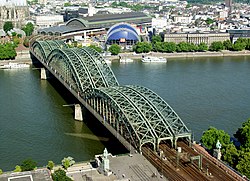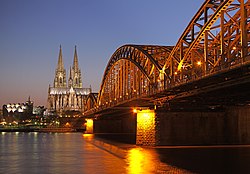Our website is made possible by displaying online advertisements to our visitors.
Please consider supporting us by disabling your ad blocker.
Hohenzollern Bridge
This article has multiple issues. Please help improve it or discuss these issues on the talk page. (Learn how and when to remove these messages)
|
Hohenzollern Bridge Hohenzollernbrücke | |
|---|---|
 Hohenzollern bridge | |
| Coordinates | 50°56′29″N 06°57′56″E / 50.94139°N 6.96556°E |
| Carries | Train and pedestrian traffic[1] |
| Crosses | River Rhine[1] |
| Locale | Cologne, North Rhine-Westphalia, Germany[1] |
| Owner | Deutsche Bahn |
| Characteristics | |
| Design | Tied arch bridge (1948)[1] |
| Material | Concrete piers with steel superstructure[1] |
| Total length | 409.19 metres (1,342.5 ft)[1] |
| Width | 26.2 metres (86 ft) (deck, 1987)[1] |
| Longest span | 167.75 metres (550.4 ft)[1] |
| No. of spans | 118.88 metres (390.0 ft) - 167.75 metres (550.4 ft) - 122.56 metres (402.1 ft) (1987)[1] |
| History | |
| Constructed by | Krupp Maschinen- und Stahlbau (steel), Grün & Bilfinger and Heinrich Butzer (concrete) 1946 August Klönne and Stahlbau Albert Liesegang (steel), Philipp Holzmann AG (concrete) 1956 Hein, Lehmann & Co. and Krupp Industrietechnik GmbH and Thyssen Engineering GmbH (steel) 1986[1] |
| Construction start | 1946, 1956, 1986 |
| Construction end | 1948, 1959, 1987 |
| Construction cost | DM 14,000,000[1] |
| Location | |
 | |
Hohenzollern Bridge Hohenzollernbrücke | |
|---|---|
 Hohenzollern Bridge, with Cologne Cathedral and Museum Ludwig in the background | |
| Coordinates | see above |
| Crossed | River Rhine |
| Locale | Cologne, North Rhine-Westphalia, Germany[2] |
| Preceded by | Cathedral Bridge |
| Characteristics | |
| Design | Arch bridge with suspended deck (1911)[2] |
| Width | 32.45 metres (106.5 ft) (deck)[2] |
| Longest span | 167.75 metres (550.4 ft)[2] |
| No. of spans | 118.88 metres (390.0 ft) - 167.75 metres (550.4 ft) - 122.56 metres (402.1 ft) (1911)[2] |
| History | |
| Architect | Franz Heinrich Schwechten (1911)[2] |
| Construction start | 1907 |
| Construction end | 1911 |
| Collapsed | 6 March 1945[2] |
The Hohenzollern Bridge (German: Hohenzollernbrücke) is a bridge crossing the river Rhine in the German city of Cologne (German: Köln). It crosses the Rhine at kilometre 688.5. Originally, the bridge was both a railway and road bridge. However, after its destruction in 1945 and subsequent reconstruction, the bridge has been only accessible to rail and pedestrian traffic.
It is the most heavily-used railway bridge in Germany with more than 1,200 trains crossing daily,[3] connecting the Köln Hauptbahnhof and Köln Messe/Deutz stations.
- ^ a b c d e f g h i j k Hohenzollernbrücke (1987) at Structurae
- ^ a b c d e f g Hohenzollernbrücke (1911) at Structurae
- ^ DB Bahn: Hauptbahnhof Köln – Drehkreuz des Westen (in German)
Previous Page Next Page


